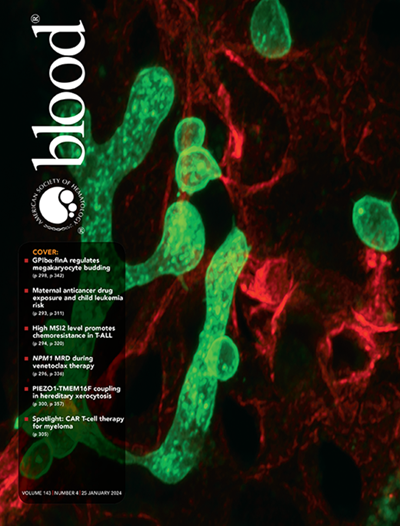Rbm38 Deficiency Impairs Erythroid Heme Biosynthesis and Induces Porphyria via Reduced Ferrochelatase Expression.
IF 23.1
1区 医学
Q1 HEMATOLOGY
引用次数: 0
Abstract
RNA splicing and processing are critical for erythropoiesis, as dysregulation of RNA splicing ultimately disrupts protein synthesis. The RNA-binding protein Rbm38 is highly expressed during terminal erythropoiesis. While in vitro studies have implicated Rbm38 as a key regulator of erythroid differentiation, the landscape of RNA splicing regulated by Rbm38 and its role in terminal erythropoiesis in vivo have not been fully elucidated. Here, we generated whole-body and conditional knockout mouse models for Rbm38 and found that mature red blood cell production was impaired in the bone marrow of Rbm38-deficient mice. Rbm38-/- red blood cells exhibited reduced hemoglobin content and increased susceptibility to oxidative stress-induced hemolysis. These mutant mice also developed microcytic hypochromic anemia, along with dysregulated iron homeostasis. Additionally, they exhibited decreased mitochondrial heme biosynthesis and accumulation of free protoporphyrin (PPIX) in erythrocytes and feces, resembling human erythropoietic protoporphyria (EPP). Mechanistically, Rbm38 regulates the incorporation of ferrous iron (Fe2+) into PPIX to form heme by modulating alternative splicing, mRNA decay, and translation of the porphyrin metabolic enzyme gene Ferrochelatase (Fech). Importantly, enforced expression of Fech largely restored erythroid differentiation defects and ameliorated anemia in Rbm38-/- transplants. We further demonstrated that genetic variants in the human RBM38 gene locus influence PPIX levels in erythrocytes from healthy cohorts. Our findings demonstrate that Rbm38 governs terminal erythropoiesis by orchestrating RNA splicing, stability, and translation during heme biosynthesis.Rbm38缺乏通过降低铁螯合酶表达而损害红系血红素生物合成并诱发卟啉症。
RNA剪接和加工对红细胞生成至关重要,因为RNA剪接失调最终会破坏蛋白质合成。rna结合蛋白Rbm38在终末红细胞生成过程中高度表达。虽然体外研究表明Rbm38是红细胞分化的关键调节因子,但Rbm38调控的RNA剪接格局及其在体内终末红细胞生成中的作用尚未完全阐明。在这里,我们建立了Rbm38的全身和条件敲除小鼠模型,发现Rbm38缺陷小鼠骨髓中的成熟红细胞生成受损。Rbm38-/-红细胞表现出血红蛋白含量降低和对氧化应激诱导的溶血的易感性增加。这些突变小鼠也会发生小细胞性低色素贫血,并伴有铁稳态失调。此外,它们表现出线粒体血红素生物合成减少和红细胞和粪便中游离原卟啉(PPIX)的积累,类似于人类红细胞生成性原卟啉症(EPP)。机制上,Rbm38通过调节卟啉代谢酶基因铁螯合酶(Ferrochelatase, Fech)的选择性剪接、mRNA衰变和翻译,调节亚铁铁(Fe2+)进入PPIX形成血红素。重要的是,在Rbm38-/-移植中,Fech的强制表达在很大程度上恢复了红细胞分化缺陷并改善了贫血。我们进一步证明,人类RBM38基因位点的遗传变异影响健康人群红细胞中的PPIX水平。我们的研究结果表明,Rbm38通过在血红素生物合成过程中协调RNA剪接、稳定性和翻译来控制终末红细胞生成。
本文章由计算机程序翻译,如有差异,请以英文原文为准。
求助全文
约1分钟内获得全文
求助全文
来源期刊

Blood
医学-血液学
CiteScore
23.60
自引率
3.90%
发文量
955
审稿时长
1 months
期刊介绍:
Blood, the official journal of the American Society of Hematology, published online and in print, provides an international forum for the publication of original articles describing basic laboratory, translational, and clinical investigations in hematology. Primary research articles will be published under the following scientific categories: Clinical Trials and Observations; Gene Therapy; Hematopoiesis and Stem Cells; Immunobiology and Immunotherapy scope; Myeloid Neoplasia; Lymphoid Neoplasia; Phagocytes, Granulocytes and Myelopoiesis; Platelets and Thrombopoiesis; Red Cells, Iron and Erythropoiesis; Thrombosis and Hemostasis; Transfusion Medicine; Transplantation; and Vascular Biology. Papers can be listed under more than one category as appropriate.
 求助内容:
求助内容: 应助结果提醒方式:
应助结果提醒方式:


